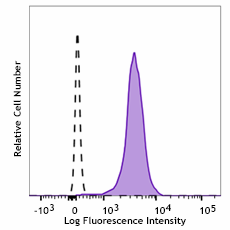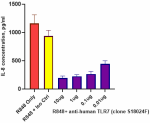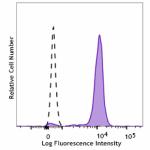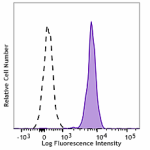- Clone
- S18024F (See other available formats)
- Regulatory Status
- RUO
- Other Names
- Toll-like receptor (TLR) 7, CD287
- Isotype
- Rat IgG2a, κ
- Ave. Rating
- Submit a Review
- Product Citations
- publications

-

Human peripheral blood plasmacytoid dendritic cells were stained with anti-human CD304, fixed and permeabilized using Cyto-Fast™ Fix/Perm Buffer Set (Cat. No. 426803) and intracellularly stained with anti-human TLR7 (clone S18024F) Brilliant Violet 421™ (closed histogram), or rat IgG2a, κ Brilliant Violet 421™ isotype control (open histogram). Histograms are gated on CD304+ plasmacytoid dendritic cells.
| Cat # | Size | Price | Quantity Check Availability | Save | ||
|---|---|---|---|---|---|---|
| 376909 | 25 tests | 172€ | ||||
| 376910 | 100 tests | 348€ | ||||
Toll-like receptor (TLR) 7, also known as CD287 is a type 1 transmembrane protein, member of the TLR receptor family. TLR7 is expressed intracellularly in plasmacytoid dendritic cells, myeloid cells, and B lymphocytes and plays an important role in the innate immune response by binding single-stranded RNA (ssRNA). TLR7 signals through MyD88, which leads to the activation and secretion of IFN-α/β and other inflammatory cytokines.
Product DetailsProduct Details
- Verified Reactivity
- Human
- Antibody Type
- Monoclonal
- Host Species
- Rat
- Formulation
- Phosphate-buffered solution, pH 7.2, containing 0.09% sodium azide and BSA (origin USA)
- Preparation
- The antibody was purified by affinity chromatography and conjugated with Brilliant Violet 421™ under optimal conditions.
- Concentration
- Lot-specific (to obtain lot-specific concentration and expiration, please enter the lot number in our Certificate of Analysis online tool.)
- Storage & Handling
- The antibody solution should be stored undiluted between 2°C and 8°C, and protected from prolonged exposure to light. Do not freeze.
- Application
-
ICFC – Quality tested
- Recommended Usage
-
Each lot of this antibody is quality control tested by intracellular immunofluorescent staining with flow cytometric analysis. For flow cytometric staining, the suggested use of this reagent is 5 µL per million cells in 100 µL staining volume or 5 µL per 100 µL of whole blood. It is recommended that the reagent be titrated for optimal performance for each application.
Brilliant Violet 421™ excites at 405 nm and emits at 421 nm. The standard bandpass filter 450/50 nm is recommended for detection. Brilliant Violet 421™ is a trademark of Sirigen Group Ltd.
Learn more about Brilliant Violet™.
This product is subject to proprietary rights of Sirigen Inc. and is made and sold under license from Sirigen Inc. The purchase of this product conveys to the buyer a non-transferable right to use the purchased product for research purposes only. This product may not be resold or incorporated in any manner into another product for resale. Any use for therapeutics or diagnostics is strictly prohibited. This product is covered by U.S. Patent(s), pending patent applications and foreign equivalents. - Excitation Laser
-
Violet Laser (405 nm)
- Application Notes
-
Clone S18024F can be used for blocking R848-activated IL8 cytokine secretion (tested on 293XL/TLR7 cell line) and for intracellular flow cytometry.
- RRID
-
AB_2922601 (BioLegend Cat. No. 376909)
AB_2922601 (BioLegend Cat. No. 376910)
Antigen Details
- Structure
- Type 1 transmembrane protein, member of the Toll-like receptor (TLR) family
- Distribution
-
Expressed intracellularly in plasmacytoid dendritic cells, myeloid cells, and B lymphocytes, Monocytes
- Function
- Pattern recognition receptor that detects single-stranded RNA, induces proinflammatory cytokine production
- Interaction
- B cells, Dendritic cells
- Ligand/Receptor
- Single-stranded RNA
- Cell Type
- B cells, Dendritic cells
- Biology Area
- Immunology, Innate Immunity
- Molecular Family
- CD Molecules, Innate Immune Signaling
- Gene ID
- 51284 View all products for this Gene ID
- UniProt
- View information about TLR7 on UniProt.org
Related FAQs
- What is the F/P ratio range of our BV421™ format antibody reagents?
-
It is lot-specific. On average it ranges between 2-4.
Other Formats
View All TLR7 Reagents Request Custom Conjugation| Description | Clone | Applications |
|---|---|---|
| PE anti-human TLR7 | S18024F | ICFC |
| FITC anti-human TLR7 | S18024F | ICFC |
| Brilliant Violet 421™ anti-human TLR7 | S18024F | ICFC |
| Ultra-LEAF™ Purified anti-human TLR7 | S18024F | Block,ICFC |
| APC anti-human TLR7 | S18024F | ICFC |
Compare Data Across All Formats
This data display is provided for general comparisons between formats.
Your actual data may vary due to variations in samples, target cells, instruments and their settings, staining conditions, and other factors.
If you need assistance with selecting the best format contact our expert technical support team.
-
PE anti-human TLR7

Human peripheral blood plasmacytoid dendritic cells were sta... -
FITC anti-human TLR7

Human peripheral blood plasmacytoid dendritic cells were sta... -
Brilliant Violet 421™ anti-human TLR7

Human peripheral blood plasmacytoid dendritic cells were sta... -
Ultra-LEAF™ Purified anti-human TLR7

Human 293XL-hTLR7 transfected cells were treated with R848 o... 
Human peripheral blood plasmacytoid dendritic cells were sta... -
APC anti-human TLR7

Human peripheral blood plasmacytoid dendritic cells were sta...
 Login / Register
Login / Register 













Follow Us